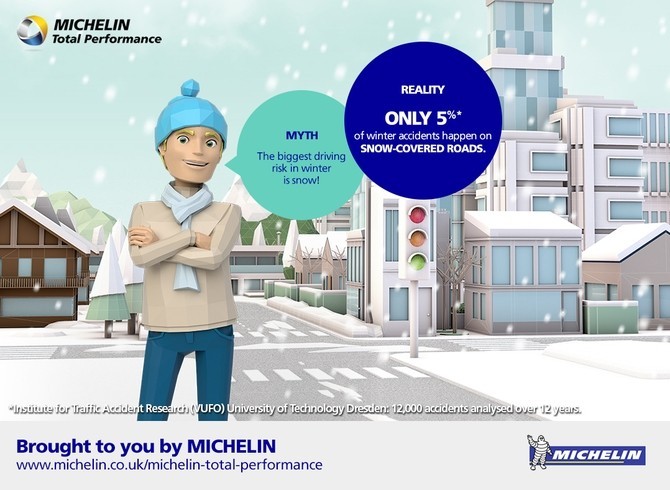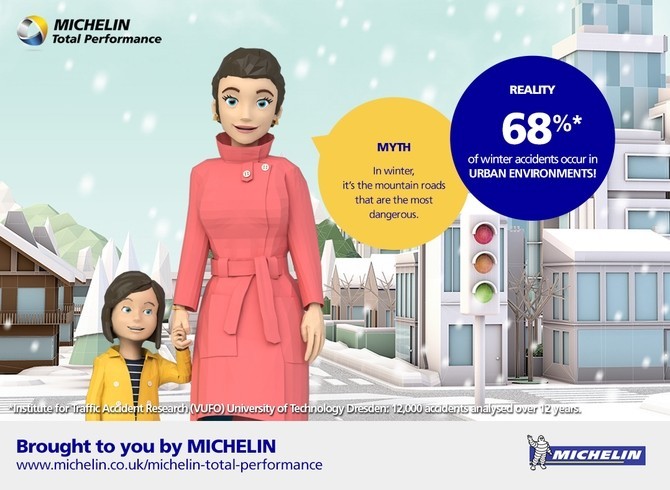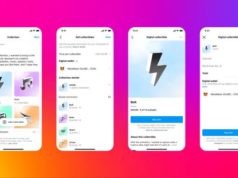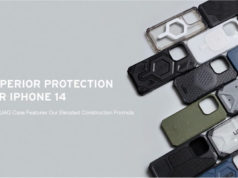Michelin have been providing road users with excellent tire service since 1888, and they’re still focused on improving on our driving usage. Michelin didn’t stop at just making innovative tires, the company also conducts 75,000 tests a year with consumers to gather accurate and up to date knowledge about drivers and the driving conditions which they face every season. The Michelin Road Usage Lab initiative was born sometime in August, with the sole aim of installing monitoring equipment in 3,000 cars across Europe to extract useful analysis of what drivers face on the road.
The most recent Road Usage Lab campaign wants to debunk most myths and misconceptions we have about driving in winter, and winter tires in general. Winter is around the corner, and Michelin’s series of videos and infographics will teach you a thing or two before you pop on those winter tires for your next ski trip. See the complete press post below for the 5 Things to Know when driving in Winter.
5 Things to Know
WINTER HUMAN INTEREST
Winter Driving Worries? 5 Things To Know
Driving in the winter season brings many concerns. For most Mums, the biggest concern is the children in the back seat! But if you’re faced with the school run, shopping, or a work commute, you don’t have a choice.
Don’t worry! Because research from Michelin’s Road Usage Lab suggests some of those can be handled. Let’s explode some motoring myths.
Myth #1: Snow is the biggest driving menace
Did you know that in the winter season, 95% of road accidents are not on snowy roads? There’s more: in one study from VUFO, 57%occurred when the road wasn’t even wet.
What does matter is the temperature – cold weather causes rubber to harden, reducing grip. Cold weather tires are specifically designed to reduce the impact of this hardening, maintaining good grip. That’s why it’s important to check you’re using the right rubber, whatever the weather forecast is.

Myth #2: Winter tires mean snow tires
A surprising number of drivers think winter tires only work when the white stuff’s on the ground. In fact, winter conditions include cold weather freezing fog, heavy rain, black ice… the list goes on.
In winter and cold weather conditions, getting where you’re going means being able to stop. And winter-grade tires perform better under braking in all cold conditions. At under 6°C on a dry surface, a properly equipped car will take FOUR METRES less distance to stop from 49 mph. A whole car’s length distance!
Myth #3: The city’s safer than the country
Not many Mums look forward to the twisty, turny tracks in rural areas. But in fact, fewer accidents happen in the countryside – over two-thirds (68%) of reportable incidents in winter happen in the city!
Yes, those well-lit, well-salted urban streets can be riskier than a mountain track. Why? Because all that stop-start driving increases the chance of skids and shunts. More braking and more cornering mean more opportunities for something to happen! Fortunately, preparing your car for winter makes a big difference.
So even if your driving is limited to around town, don’t lose focus. Switching to winter tires will keep your family safe.
Myth #4: It’s not worth changing tires for a short ski trip –
NB : This myth can be not relevant for the UK there holiday ski home won’t be just a few miles away.
When you’ve planned a weekend away – a ski chalet? A mountain cottage? – it’s tempting to put off changing to winter rubber. After all, it takes time to change your tires… and it’s only a couple of hours’ drive to your holiday home!
But ski slopes are by definition…. slopey. And a proper winter tire increases traction on hills by a staggering percent – in cold conditions, the right tires will get you up a 13% gradient! And keep you safe going down again. So don’t get stuck on the hills, even if it’s a short trip.
Myth #5: Winter tires slow you down
Some people complain that winter tires feel heavy and sluggish. Well, there’s a reason for that – you’re on snow and ice! And in such conditions cold-weather tires perform much more efficiently than summer ones.
Take acceleration. Of course you’re careful about your speed in winter. But a winter tire can get you up to speed much more efficiently than leaving your summer rubber on. Because on snow, a winter set gets you moving three times faster, thanks to better grip and low-temperature performance.
So whatever your driving tasks are this winter, check what’s on your wheels. Because every busy Mum needs the right tires for the season!
If you’re intrigued by the difference winter tires make, check out Michelin’s Road Usage Lab. The company from Clermont-Ferrand has been gathering knowledge about how we drive for 125 years plus… and it never stops. They’re uncovering fresh insights about how we really use our cars today – including the surprises above. How? By watching thousands of drivers each year, in hundreds of varied driving conditions, all over Europe. All with one purpose: to make your driving experience as safe as it can be. Read more at www.michelin.co.uk/michelin-total-performance
Source: Michelin





































